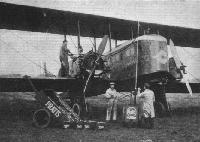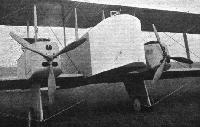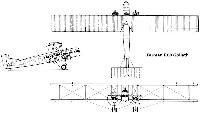
Описание
Страна : Франция
Год : 1918
Транспортный самолет с экипажем из двух человек
Варианты
- Farman - F.60 Goliath / F.169 - 1918 - Франция
- Farman - F.62BN.4 / F.160 Goliath - 1922 - Франция
- Farman - F.140 / F.4S Super Goliath - 1923 - Франция
- Farman - F.62 - 1924 - Франция
Farman F.60
F.60 Goliath, самый массовый из двухдвигательных самолетов первого десятилетия, после завершения Первой мировой войны строился и варианте авиалайнера, свыше 60 экземпляров которого работали на регулярных линиях в Европе и Южной Америке, и в качестве ночного бомбардировщика и торпедоносца, построенного в количестве 300 штук для Франции и зарубежных покупателей. Первый FF.60 (FF от Farman Freres) разрабатывался в 1918 году как бомбардировщик, который Франция предполагала использовать в кампании 1919 года. Когда в ноябре 1918 года было заключено перемирие, два прототипа, находившихся в высокой стадии готовности, были переделаны в гражданский вариант, с кабинами в носовой и средней части фюзеляжа, вмещавшими четыре и восемь пассажиров, соответственно. Первый самолет был продемонстрирован публике в январе 1919 года и в том же месяце поднялся в воздух. 8 февраля, пилотируемый лейтенантом Боссутро, он совершил перелет из Тусб-ле-Нобль на британскую авиабазу Кинли в Суррее, имея на борту 11 военнослужащих в качестве пассажиров. Этот примечательный полет вскоре после начала испытаний, некоторые ошибочно называют первым регулярным международным пассажирским рейсом.
Пока бомбардировщик проходил испытания, гражданский F.60 был запущен в серию. Были совершены несколько впечатляющих полетов, включая состоявшийся в августе 1919 года перелет протяженностью 2050 км из Парижа в Касабланку во Французском Марокко, который экипаж из шести человек совершил за 18 ч 23 мин. 29 марта 1920 года F.60 вышел на линию авиакомпании "Compagnie des Grands Express Aeriens" между Ле-Бурже и Кройдоном. Менее чем через четыре месяца "Lignes Farman", дочерняя компания авиапроизводителя, открыла линию между Парижем и Брюсселем, которую к концу 1921 года продлили через Амстердам до Берлина. К тому времени второй французский оператор, "Compagnie des Messageries Aeriennes", начал эксплуатацию Goliath на линии между Парижем и Лондоном. Четвертой французской компанией, купившей Goliath, стала "Compagnie Aerienne Francaise", а румынская LARES стала использовать Goliath с британскими радиальными двигателями Armstrong Siddeley Jaguar. Авиакомпания SNETA (предшественница бельгийской SABENA) использовала шесть самолетов. Другие Goliath были проданы авиакомпаниям Южной Америки.
В Чехословакии фирмы "Avia" и "Letov" выпускали Goliath по лицензии, устанавливая на них лицензионный вариант радиального двигателя Bristol Jupiter.
Пять машин были куплены чешской национальной авиакомпанией CSA, а шесть самолетов использовались чешскими ВВС для перевозки VIP-персон. Опытный санитарный вариант Goliath, рассчитанный на перевозку 12 лежачих больных, врача и медсестры, так и остался в единственном экземпляре.
Варианты
FF.60: три прототипа, вероятно, два гражданских и один военный, построенных в начале 1919 года
F.60: основной гражданский вариант, ранние машины оснащены парой радиальных двигателей Salmson Z.9, а поздние - Salmson CM.9 мощностью по 260 л.с. (194 кВт); было построено свыше 60 гражданских Goliath, большинство из которых соответствовало стандарту F.60; один гражданский F.60 использовался ВМС Франции для испытаний двухпоплавкового шасси
F.60bis: гражданский вариант с двигателями Salmson 9Az в 300 л.с. (224 кВт)
F.61: гражданский вариант с двигателями Renault 12Fe по 300 л.с. (224 кВт)
F.169: усовершенствованный вариант Goliath, начавший службу в "Lignes Farman" в 1929 году, с улучшенной аэродинамикой и новым шасси с одиночными колесами на основных стойках
ТАКТИКО-ТЕХНИЧЕСКИЕ ХАРАКТЕРИСТИКИ
Farman F.60
Тип: транспортный самолет с экипажем из двух человек
Силовая установка: два радиальных двигателя Salmson CM.9 мощностью по 260 л. с. (194 кВт)
Летные характеристики: максимальная скорость у земли - 140 км/ч; крейсерская скорость на высоте 2000 м -120 км/ч; потолок 4000 м; дальность полета 400 км
Масса: пустого 2500 кг; максимальная взлетная 4770 кг
Размеры: размах крыла 26,50 м; длина 14,33 м; высота 4,91 м; площадь крыльев 161,00 м2
Полезная нагрузка: до 12 пассажиров в двух кабинах
Описание:
- Farman F.60
- Flight, December 1919
SOME FRENCH MACHINES AT THE SHOW - Flight, January 1920
The Paris Aero Show 1919
Фотографии
-
Мировая Авиация 126
Регистрационный номер: F-AECU [2] Флот Goliath авиакомпании "Air Union" включал базовый вариант F.60 с двигателями Salmson. Этот самолет нес имя "Normandie". Обратите внимание на открытую кабину экипажа.
-
Aeroplane Monthly 1983-12 / J.Stroud - Wings of Peace
Регистрационный номер: F-ADFQ [2] Farman Line's F.61 Goliath F-ADFQ (construction number 42) with Renault 12Fe water-cooled 12-cylinder vee engines.
The 8-passenger 85-m.p.h. Farman Goliath (1921) -
Flight 1930-01 / Flight
The Farman Goliath;
-
Aeroplane Monthly 1983-12 / J.Stroud - Wings of Peace
The prototype Farman F.60 Goliath transport. The humped-back appearance of the early examples can be seen and the nacelles are shallower than on production aeroplanes.
-
Air Pictorial 1957-06 / Photos by request
Окончание Первой Мировой сократило деловую активность в военном авиастроении, но некоторые проекты, как, например, французский тяжелый бомбардировщик F.60 "Голиаф", имели настолько значительный потенциал, что их без труда адаптировали для использования в коммерческих целях. Один из первых F.60 с моторами Salmson 9Z
The prototype Farman F.60 Goliath, a 2-motor biplane which served for many years in both military and civil guises. As a transport the F.60 could carry 12 passengers , power being two 260-h .p. Salmson C.M.9 watercooled radials - later versions had Gnome-Rhone, Jupiter or Lorraine radials. Span 87 ft., length 48 ft. 5 in . -
Aeroplane Monthly 1983-12 / J.Stroud - Wings of Peace
Регистрационный номер: F-ADFQ [2] This view of Farman Line's F.61 Goliath F-ADFQ at Haren Airport, Brussels, shows to advantage the tail unit and the passenger entrance door.
-
Flight 1920-04 / Flight
THE OPENING OF WADDON AIR PORT: After serving as the London Terminus for continental air traffic for several months, Hounslow aerodrome has been relinquished for the use of Cavalry, and the port arrangements have been transferred to Waddon, near Croydon, from which air port traffic was inaugurated on Monday of this week. Our photo show the Farman Goliath ready for the trip to Paris.
-
Flight 1919-12 / Flight
The Farman Goliath: Side view
-
Aeroplane Monthly 1983-12 / J.Stroud - Wings of Peace
Регистрационный номер: F-AECU [2] Air Union's F.60 F-AECU Normandie at Croydon, with cargo being loaded through the nose door.
-
Aeroplane Monthly 1983-12 / J.Stroud - Wings of Peace
Регистрационный номер: F-AEFC Air Union's F.60 Goliath F-AEFC Provence (construction number 6943/7) at Croydon during night flying trials, probably in May 1927.
-
Flight 1926-12 / Flight
Air Services and "Pratt's": One of the French Air Union Farman Goliath air liners, employed on the Paris-London service, filling up with "Pratt's" at Croydon.
-
Авиация и Время 1999-02 / В.Котельников - Библейский герой в Красной Армии /Аэроархив/
Французский гражданский Goliath F.61
-
Aeroplane Monthly 1983-12 / J.Stroud - Wings of Peace
Регистрационный номер: O-BLON SNETA’s light blue Goliath O-BLON with 260 h.p. Maybach engines.
-
Мировая Авиация 45
Регистрационный номер: F-ADDT [3] 8 февраля 1919г.: первых пассажиров на линии Париж-Лондон перевез на самолете Farman F60 летчик Люсьен Боссю.
Farman F.60 Goliaths at Le Bourget. -
Aeroplane Monthly 1984-04 / Skywriters
Регистрационный номер: F-AEGP [2] This photograph of Air Unions F.60 F-AEGP Flandre has been sent to us by Rob Glover. The aircraft looks more ready for work than she appeared on page 662 in the December 1983 issue.
-
Air Pictorial 1955-04 / Photos by request
Регистрационный номер: F-AEGQ FARMAN GOLIATH. A successful twin-motor transport of the immediate post-World War I era was the Farman F.60 Goliath biplane. Initially fitted with 260-h.p. Salmson radials, it later operated on the Croydon to Paris route with 350-h.p. Renault engines. One other version had 400-h.p. Lorraine Dietrich engines. The F.61 in modified form was used by the French Air Force as a bomber. Span was 92 ft. 6 in.; length 46 ft. 3 in.; all-up weight 10,200 lb.; and top speed with Salmsons, 100 m.p.h. The Goliath could carry twenty passengers.
-
Авиация и Время 1999-02 / В.Котельников - Библейский герой в Красной Армии /Аэроархив/
Регистрационный номер: L-BAGE Goliath F.62, выпущенный чешской авиафирмой Letov
-
Авиация и Время 1999-02 / В.Котельников - Библейский герой в Красной Армии /Аэроархив/
Регистрационный номер: L-BAGF Goliath F.62 французского производства, принадлежавший чешской авиакомпании CSA
-
Aeroplane Monthly 1990-08 / P.Kucera - Czech fifties (1)
L-BAHD being manhandled. Note the non-standard wheels with square cross-section tyres, possibly taken from a Farman Goliath, an example of which can be seen in the background.
Другие самолёты на фотографии: De Havilland D.H.50 - Великобритания - 1923
-
Flight 1920-01 / Flight
The Farman "Goliath": A similar machine was used in the Paris-Dakar flight
-
Flight 1920-01 / Flight
THE PARIS AERO SHOW: the Farman Goliath in the foreground
-
Aeroplane Monthly 1984-06 / J.Stroud - Wings of Peace
Imperial Airways' G-EBBY at Brussels, with a Farman Goliath and a Sabena Handley Page W.8b in the background.
Другие самолёты на фотографии: De Havilland D.H.32 / D.H.34 - Великобритания - 1921Handley Page H.P.18 (W.8) / H.P.30 (W.10) - Великобритания - 1919
-
Aeroplane Monthly 1984-06 / J.Stroud - Wings of Peace
Another view of Daimler's G-EBBS, photographed this time at Croydon (Plough Lane), with the Handley Page W.8b Prince Henry and two Farman Goliaths in the background.
Другие самолёты на фотографии: De Havilland D.H.32 / D.H.34 - Великобритания - 1921Handley Page H.P.18 (W.8) / H.P.30 (W.10) - Великобритания - 1919
-
Flight 1922-02 / Flight
FROM THE AIR CONFERENCE VISIT TO WADDON: The photograph gives a good idea of the different types of machines on view. Vickers "Vimys," "D.H." monoplane, and several types of "D.H." biplanes, Bristol Ten-seater, Farman Goliaths, etc.
Другие самолёты на фотографии: Bristol Ten-Seater / Brandon - Великобритания - 1921De Havilland Doncaster / D.H.29 - Великобритания - 1921Vickers Vimy Commercial - Великобритания - 1919
-
Flight 1926-05 / Flight
CROYDON DURING THE STRIKE: The general strike resulted in a vast increase in the air traffic between Croydon and the Continent and a great number of extra machines were called into service. Shown a line-up of machines, among which may be recognised two Farman "Goliaths," a Spad, and two Handley-Page W.10's.
Другие самолёты на фотографии: Bleriot-SPAD S.33 / S.46 / S.50 / S.56 / S.66 - Франция - 1920Handley Page H.P.18 (W.8) / H.P.30 (W.10) - Великобритания - 1919
-
Flight 1921-04 / Flight
Регистрационный номер: F-FHMU [2] Departure from Croydon: The French Goliath, "F-FHMU," gets away for Paris.
-
Aeroplane Monthly 1983-12 / J.Stroud - Wings of Peace
Регистрационный номер: F-ADDT [3] Air Union's Goliath F-ADDT Languedoc. This picture appears to have been taken after its conversion to F.63 with Jupiter 9Ab engines.
-
Air-Britain Archive 1980-01
The third SABCA-built D.H.50 for Sabena. The aircraft in the air is a Farman Goliath.
This DH.50A O-BAHX was built by SABCA and ended its days in the Congo.Другие самолёты на фотографии: De Havilland D.H.50 - Великобритания - 1923
-
Flight 1922-10 / Flight
The Farman "Goliath" upon which Bossoutrot made his record flight, as recorded last week in "Flight." Note the pair of Leitner-Watts 3-bladed metal air-screws which helped the French machine to victory. Moreover, these nine-foot propellers are entirely British, being designed by Mr. Watts, and manufactured for the Metal Air-Screw Co., Ltd., at Messrs. Rubery Owen's well-known works.
-
Aeroplane Monthly 1983-12 / J.Stroud - Wings of Peace
Регистрационный номер: F-AIZX F-AIZX, the prototype Farman F.169, with Gnome-Rhone Jupiters, revised undercarriage, 12 passenger seats and full-width two-seat cockpit
-
Flight 1924-04 / Flight
A FRENCH RECORD-BREAKER: The Farman "Goliath" fitted with floats on which Georges Rene established a world's altitude record for seaplanes carrying a useful load of 1,000 kgs., at St. Raphael on April 4. In a flight lasting 1 hr. 20 mins. he reached an altitude of 3,300 m., thus beating the previous record of 2,432 m. made by E. Dolecek (U.S. Air Service) on an F-5-L flying boat. The above "Goliath" is fitted with two 230 h.p. C.U.Z.9 Salmson engines.
-
Flight 1919-12 / Flight
THE FARMAN GOLIATH: View inside the cabin
-
Aeroplane Monthly 1983-12 / J.Stroud - Wings of Peace
View from the rear of a Goliath's main cabin. This is thought to be a fairly late photograph taken in an Air Union aircraft. The pilot's position is beyond the semi-bulkhead on the left. Tables can be seen fitted. Also visible is the cable fuselage bracing.
-
Jane's All the World Aircraft 1980 / Encyclopedia of Aviation - Aircraft A-Z - v3
29 марта 1920г.: авиакомпания "Cie des Grands Express Aeriens" начала эксплуатацию самолета Farman F.60 Goliath с роскошным салоном на линии Париж-Кройдон. Средняя скорость самолета на маршруте составляла 130 км/ч, время полета из Парижа до Лондона - 2 ч 50 мин.
Retouched photograph of the interior of a Farman F.60 Goliath airliner. -
Aeroplane Monthly 1977-01 / G.Endres - Czechoslovakian Air Transport since 1920 (1)
Регистрационный номер: L-BALF Farman Goliath L-BALF, right, was a Farman-built machine, although many of CSA’s Goliaths were Czech-built at the Avia and Letov works.
-
Air-Britain Archive 1981-04
Регистрационный номер: F-GEAB 24.11.27 The Goliath was F-GEAB 'Savoie', c/n 5, and Yaldham Manor is near Sevenoaks. It seems that the pilot attempted to land in a field but bounced over a hedge into the next field and had to be extricated from the aircraft by onlookers with a fencing stake. The aircraft clearly survived the incident.
31.7.29 This was the same Farman Goliath, F-GEAB, as mentioned in the Yaldham Manor incident on 24.11.27. On this occasion it was carrying bullion from London to Paris and required to make a forced landing in a field at Smarden adjoining the river Beult. The wind blew the aircraft across the field and only the presence of some bushes on the bank prevented it from continuing into the river. Some of the gold was thrown out into the river by the impact, to be recovered by spectators - no doubt under strict supervision! (Where were the police? - Ed.)
The Farman Goliath F-GEAB which apparently developed a liking for Kentish fields. This photograph shows it on the later date after the forced landing at Smarden with a group of local gold prospectors in the foreground! -
Aeroplane Monthly 1984-08 / R.Brooks - Penshurst /Gone but not forgotten/ (15)
Регистрационный номер: F-FHMY Two views of the luckless Air Union Farman F.63bis F-FHMY Picardie after a forced landing at Penshurst. On February 10, 1930 the same aircraft made another crash landing at Marden Park, Kent. The Farman caught fire
and two passengers perished on an inbound flight from Paris to Croydon. -
История Авиации 2002-06 / С.Корж - Коммерческая авиация /Ретроспектива/ (5)
Первая попытка трансконтинентального перелета из Европы в Африку на "Голиафе", как и положено, провалилась. К счастью, благодаря опыту пилота и элементарному благоразумию путешественников, эта затея обошлась без жертв.
-
Aeroplane Monthly 1983-12 / J.Stroud - Wings of Peace
Регистрационный номер: F-AEGP [2] Air Union's F.60 Goliath F-AEGP Flandre after a mishap in Southern England. The engines in this picture are Salmsons so Flandre must have been rebuilt because it was at one time reported as a Jupiter-powered F.63bis.
-
История Авиации 2002-06 / С.Корж - Коммерческая авиация /Ретроспектива/ (5)
Регистрационный номер: F-ADDT [3] -
Aeroplane Monthly 1983-12 / J.Stroud - Wings of Peace
Регистрационный номер: F-FHMU [2] Compagnie des Grands Express Aeriens' Farman Goliath F-FHMU
-
Flight 1920-01 / Flight
Sketch showing the undercarriage of the Farman "Goliath."
-
Мировая Авиация 126
Farman F.60 Goliath
- Фотографии











































